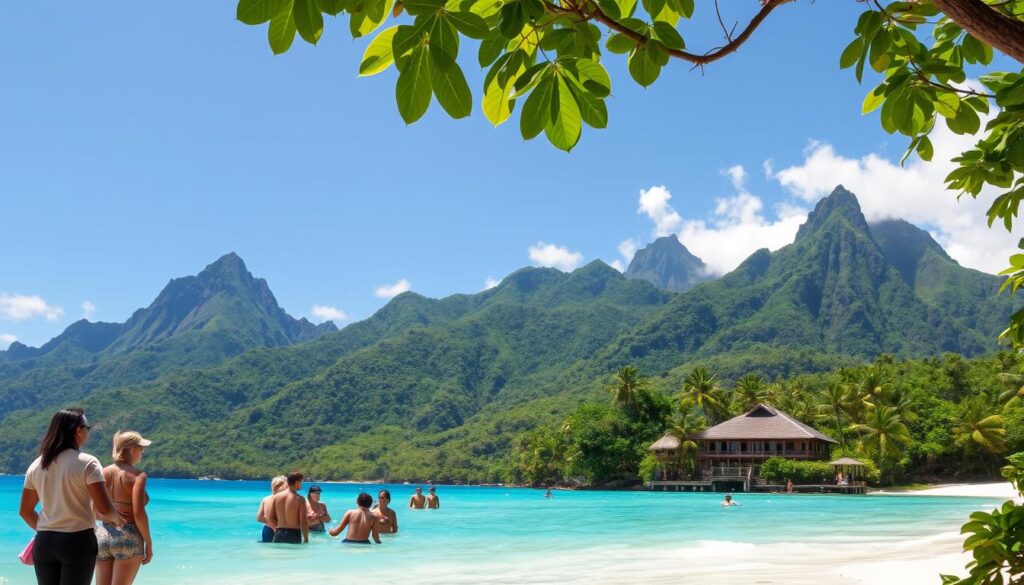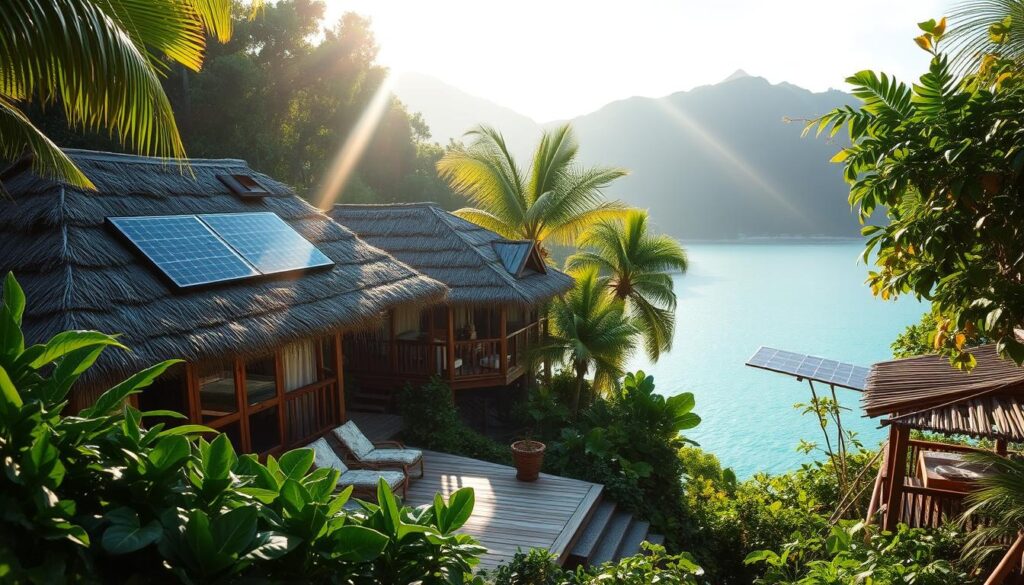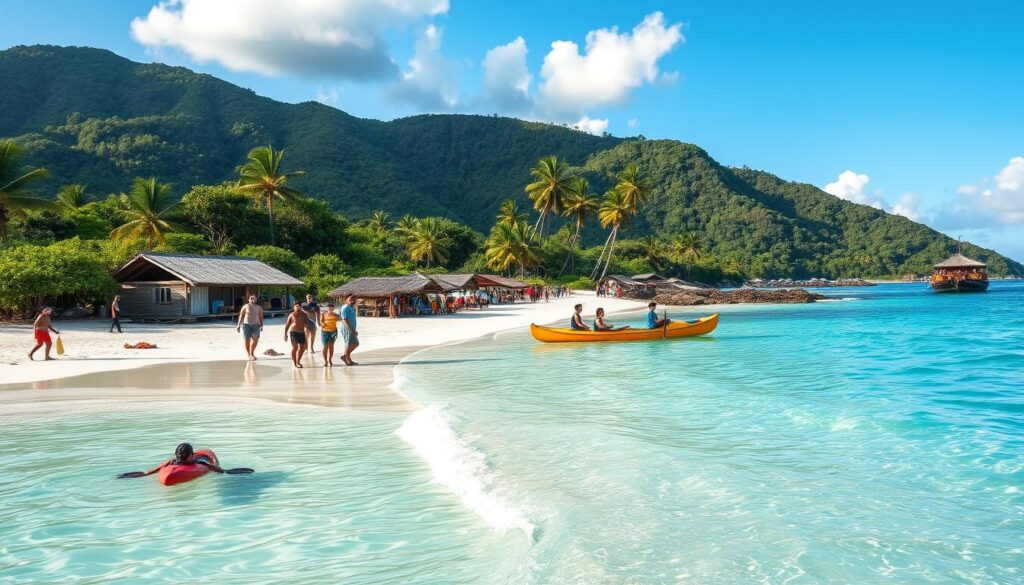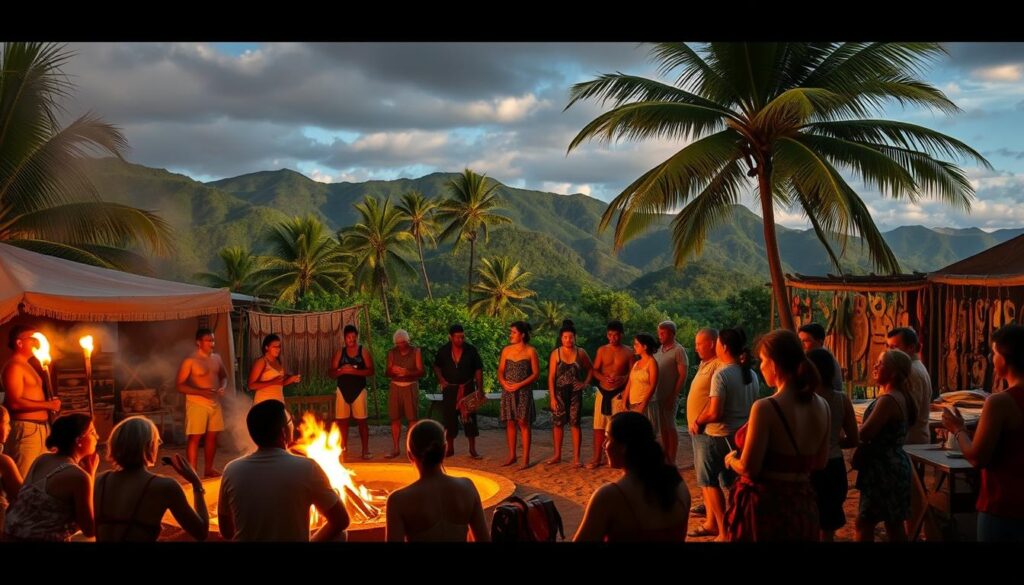Did you know tourism is a big contributor to global greenhouse gas emissions, over 8%? As more people travel, it’s key to learn how to do it right. The South Pacific, with its amazing landscapes and cultures, is facing big environmental challenges. By traveling responsibly, you can help local communities and keep the beauty of these islands alive.
Key Takeaways
- Understanding the impact of tourism on the environment is vital.
- Eco-friendly vacations support local economies and minimize damage to ecosystems.
- Responsible tourism encourages sustainable practices among travelers and businesses.
- Adopting green travel tips can significantly reduce your carbon footprint.
- Engaging with local cultures enriches your travel experience.
Understanding Sustainable Travel in the South Pacific
Sustainable travel in the South Pacific means visiting these beautiful islands with care. It’s about respecting their environment and culture. This way, you help preserve the unique wildlife and rich traditions of the area.
By choosing eco-friendly places to stay and supporting local businesses, you make a positive impact. Your actions help protect these sensitive areas from the harm caused by too many tourists.
Travelers who care about the planet can enjoy their trips more. They can stay in places that are good for the environment and support local people. This makes your visit better and helps the communities you see.
As you explore the South Pacific’s beauty, think about how your choices matter. Your decisions can help keep these islands beautiful for future visitors.
Why Responsible Tourism Matters
Responsible tourism means respecting local communities and the environment. As tourism grows in the South Pacific, it’s key to understand its effects. It can help local jobs and support businesses.
But, without careful practices, it can harm cultures and the environment. This is why we need to focus on responsible tourism.
Practicing ethical travel is important for a sustainable tourism approach. When travelers act responsibly, they help protect the environment and cultures in the South Pacific. Local communities benefit from projects that teach visitors about their heritage.
Many examples show how local people gain from responsible tourism. Community projects share traditions, arts, and food with visitors. This way, tourists get real experiences and help the community grow.
Together, we can make tourism a positive force. It’s about finding a balance between visitors and the places they visit.

How Climate Change Affects South Pacific Islands
The South Pacific islands are feeling the effects of climate change. They face rising sea levels, more intense natural disasters, and damaged habitats. Many islands might become too wet to live on, forcing people to think about moving.
Climate change also threatens the unique wildlife of the South Pacific. Changing weather and warmer oceans harm these ecosystems. This puts marine life, vital for the environment and local jobs, at risk.
It’s vital to protect the environment in these areas. By spreading the word and taking action, we can fight climate change together. Saving these delicate ecosystems helps both people and animals survive the growing environmental threats.
How to Travel Sustainably in the South Pacific: Eco-Tips
Traveling sustainably in the South Pacific means making choices that help the environment and local people. By choosing eco-friendly options, you make your trip better and help keep these places beautiful for others in the future.
The Importance of Choosing Eco-Friendly Accommodations
Choosing eco-friendly places to stay is key to sustainable travel in the South Pacific. Look for hotels or resorts that use solar power or sustainable materials. Staying at places owned by locals can also give you a deeper connection to the culture.
Supporting Local Economies Through Tourism
When you travel, you can help local economies grow by making smart choices. Buy from local markets and use local guides. This way, your money helps the community and supports responsible tourism, making your trip more meaningful.

Green Travel Tips to Minimize Your Carbon Footprint
Learning and using green travel tips can help reduce your carbon footprint in the South Pacific. Making small changes in your daily life can lead to more sustainable travel. This section will show you how to cut down on plastic waste and be more eco-friendly.
Reducing Plastic Waste While Traveling
Plastic pollution is a big problem in many places you might visit. Here are some ways to make a difference:
- Carry a reusable water bottle to avoid buying bottled water.
- Use cloth bags for shopping to avoid plastic bags.
- Choose reusable utensils and straws instead of single-use ones.
- Stay in places that care about the environment and use less plastic.
Adopting Eco-Conscious Travel Habits
Being aware and taking action is key to reducing carbon footprint while traveling. Here are some eco-friendly habits to adopt:
- Use public transport, bikes, or walk when you can.
- Join local conservation efforts or community activities.
- Save energy by turning off lights and electronics in your room.
- Support local businesses that focus on sustainability.
By following these green travel tips, your trip to the South Pacific can help the environment. Together, we can protect the unique ecosystems and cultures of this region.
Responsible Activities to Enjoy in the South Pacific
To truly enjoy the South Pacific, dive into nature and local culture. Sustainable tourism here means doing activities that are good for the environment and help communities. By choosing eco-friendly tourism, you can travel responsibly and respect the area’s beauty and culture.
Hiking through rainforests or along the coast is a great way to connect with nature. These activities let you see amazing views while being kind to the planet. Joining guided tours led by locals not only makes your trip better but also helps protect the environment.
Snorkeling and kayaking in clear waters let you see marine life up close. Choose activities with sustainable operators to keep the waters clean. Taking part in local workshops, like crafts or cooking, is a great way to learn and support the community.

Preserving Marine Life During Your Visit
The South Pacific is home to stunning marine ecosystems. It’s your duty to protect these areas during your visit. By following practices for preserving marine life, you can enjoy the beauty of the ocean. This way, you help keep these ecosystems healthy for future generations.
Practicing Sustainable Diving and Snorkeling
Before diving or snorkeling in the South Pacific, learn about important practices. Choose operators that focus on eco-conscious travel. They should follow sustainable practices, such as:
- Using reef-safe sunscreen to avoid chemical damage to ocean waters.
- Receiving proper training on how to minimize impact on delicate coral reefs.
- Avoiding touching or standing on coral, ensuring your activities do not disturb marine life.
Knowing local guidelines will make your visit better. It also helps protect these precious environments.
Respecting Local Wildlife
Responsible interactions with marine wildlife are key. They ensure the safety of both you and the creatures. When exploring the ocean’s diversity, remember to:
- Maintain a safe distance from all marine animals, like sharks and rays.
- Avoid feeding fish, which can upset their natural behavior and diet.
- Observe marine life without using flash photography that could cause stress to creatures.
Your respect for local wildlife is vital. It helps create an environment where both travelers and marine ecosystems can thrive.
Community Engagement and Cultural Respect
Getting involved with local communities is key to responsible tourism in the South Pacific. Learning about cultural respect helps you make real connections with people. By understanding local customs and languages, you show respect and make your trip more meaningful.
Before taking photos or joining community events, always ask for permission. These actions show you value their culture and want to learn from them. It’s a small step that can make a big difference in your interactions.
| Action | Impact |
|---|---|
| Learning local languages | Builds rapport and shows respect |
| Attending cultural events | Enhances understanding of traditions |
| Supporting local artisans | Boosts economies and preserves crafts |
| Participating in community cleanup | Demonstrates commitment to preserving the environment |
Showing cultural respect and connecting with communities makes your travel more authentic. Responsible tourism in the South Pacific is about being a thoughtful visitor. It’s about building lasting relationships with local cultures and leaving a positive mark.

How to Choose Eco-Friendly South Pacific Destinations
Choosing eco-friendly south pacific destinations can make your trip better and help the planet. Start by looking for places known for protecting nature. Find areas where local governments and communities work together on environmental projects.
Look for places with green hotels and resorts. These use clean energy and teach guests how to live sustainably. This way, you can travel without harming the environment.
Think about the activities you can do. Join eco-tours that help local wildlife and teach you about nature. Helping out in conservation projects or learning about local cultures is also great.
These actions make your trip more meaningful and help the environment. They also support local people and their way of life.
Adding green vacation ideas to your plans is a good idea. Look for places that focus on ecotourism. This means they use local efforts to make your visit special and help the environment.
This approach ensures your trip is both enjoyable and responsible. It also helps places keep their beauty and resources for the future.
Conclusion
Traveling sustainably in the South Pacific is rewarding. It shows how tourism, local cultures, and the environment are connected. By following green travel advice, you make your trips better and help protect the area for the future.
Choosing eco-friendly places to stay and supporting local communities is key. It helps preserve the South Pacific’s beauty and cultures. Your actions can make a big difference.
Every choice you make on your trip matters. It’s about making sustainable choices. This way, you and the locals can live in harmony with nature.
